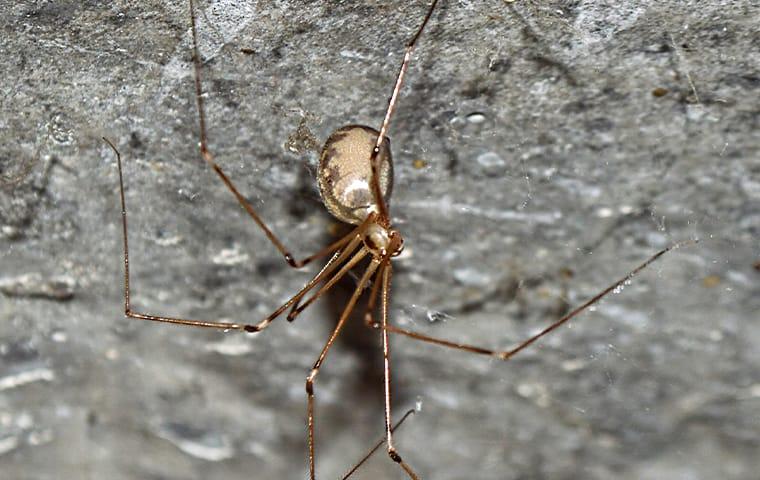You’ve probably seen the long-legged spider in the corner of your home. The cellar spider is a group of popular indoor species characterized by extremely long legs. Their bites are nonlethal and can’t pierce the human skin. While not dangerous to humans, their population can explode within your home, becoming a nuisance insect. Control the cellar spider numbers within your property through effective pest control in St. Charles.

What Does A Cellar Spider Look Like?
There are at least 20 spider species under the Pholcidae family, commonly known as the cellar spider. They have oval bodies that range in color from tan-yellow, grey, brown to black. Common classifications break the different types of cellar spiders as short-bodied and long-bodied.
Adult short-bodied females are about 1/16 inch long, with males slightly smaller. Adult long-bodied males are ¼ inch long, with females being the largest at 5/16 inches. The spiders have eight thin yet strong legs.
Short-bodies species have a leg length of approximately ⅜ inches, while their long-legged counterparts have 2-inch legs. The long legs often earn them a wrong nickname as “daddy long legs,” with most people confusing them with the harvestman arachnids.
Habits Of The Common Cellar Spider
Cellar spiders have peculiar behaviors that separate them from the different house spiders species you have within your home. Some of the habits you should know of are:
- Cellar spiders love dark, damp environments: They spin their webs in dark spaces such as eaves, crawl spaces, basements, and wine cellars, hence the name.
- Cellar spiders feed on tiny insects: The long-legged bugs feed on insects such as ants, flies, and other live spiders. They spin loose, irregular webs to trap their prey before wrapping them in silk.
- Cellar spiders hang upside down: They wait patiently for prey to touch their webs. The pests are extremely sensitive to vibrations on the nests, quickly enmeshing the target with silk before delivering a fatal bite.
- Cellar spiders also raid other spider nests: Cellar spiders are notorious for raiding nests and eating other spiders. They perform a ‘death dance,’ luring an unsuspecting bug into a trap before overpowering it.
- Cellar female spiders lay three egg sacs during their lifetime: Each egg sac contains 13-60 eggs that hatch into tiny spiderlings within three weeks. The mother abandons their hatchling immediately after they emerge from the shells.
These common habits can help you identify the cellar species within your home. Call professional pest control experts if the spider population is getting out of hand.
What Attracts Cellar Spiders In St. Charles
Cellar spiders search for cool, dark environments where they can set up their nests. Here are a few reasons why they may invade your home:
1. Plenty of Food Sources
Cellar spiders eat insects. Poor pest control measures within the home can increase the population of their favorite snack. The cellar species will invade, searching for food.
2. Warm, Dark, Moist environments
Sections of your home such as cellars, crawlspaces, basements, and attics can provide the ideal nesting place for the spiders. The long-legged critters can invade your house to find the right environment to build their nests.
Complete Spider Removal For St. Charles Residents
Cellar spiders do not pose any danger to your pets or family. However, their populations can get out of hand with the arachnids constructing messy webs all across your home. Pest Control Consultants provides effective spider control services which keep their numbers within a certain limit.
Our highly trained experts can assist in accurately identifying the species to avoid confusion with other more venomous house spiders. We use environmentally-friendly approaches to ensure the peace of mind of all in the home. Contact us today to learn more about our spider removal services.
 Customer Reviews
Customer Reviews
